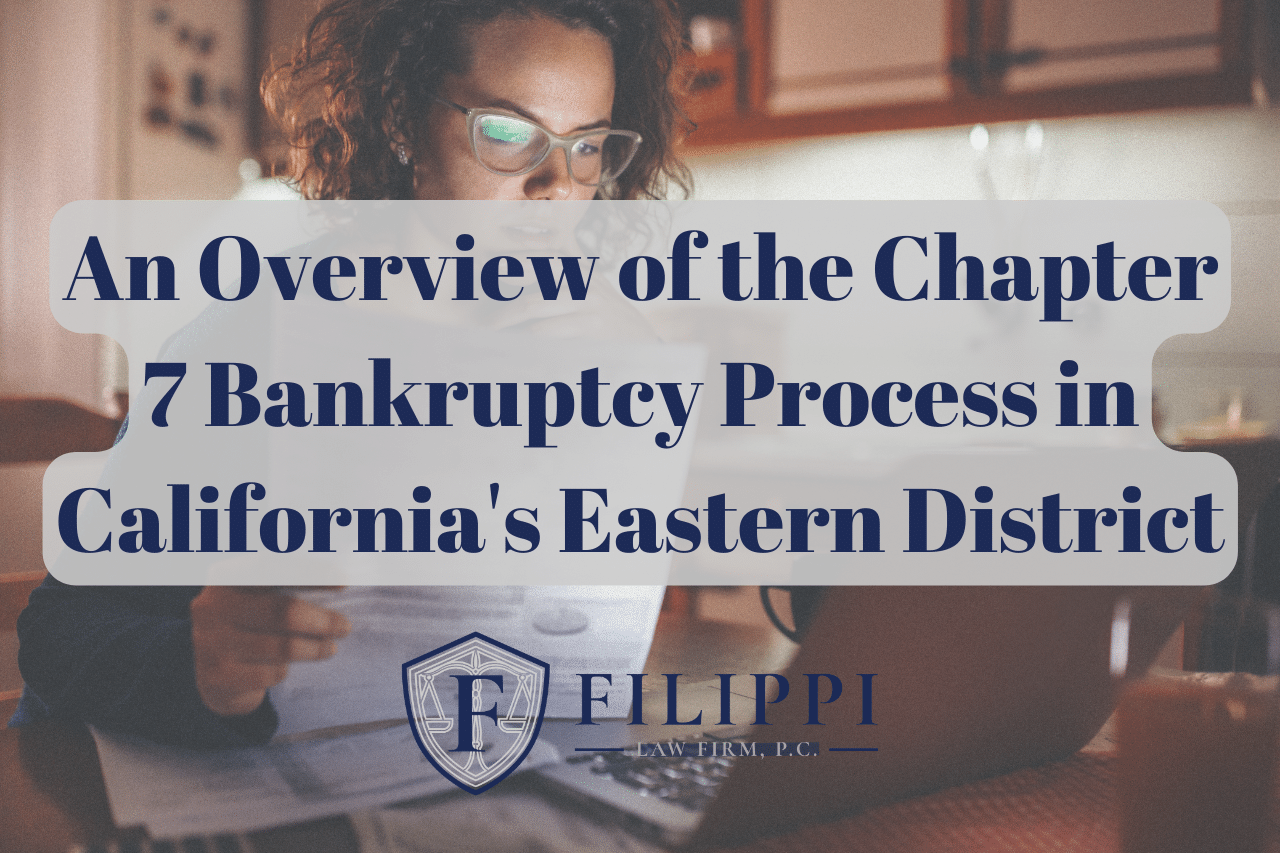
Filippi Law Firm, P.C., no longer practices bankruptcy.
The Eastern District of California is one of the most important federal judicial districts in the United States, and Chapter 7 bankruptcy is an integral part of its judicial process. This article will explore the chapter 7 bankruptcy process in the eastern district, key differences between Chapter 7 and Chapter 13 bankruptcy, how to file for Chapter 7 bankruptcy in the eastern district, and other important protections for debtors filing for chapter 7 bankruptcy. Finally, this article will discuss when filing for Chapter 7 is an appropriate choice.
What is Chapter 7 Bankruptcy?
Chapter 7 bankruptcy is a legal process available to individuals, couples, and businesses that allows them to discharge their debt obligations. This type of bankruptcy involves liquidating assets in order to pay off creditors while allowing the debtor to keep certain exempt property. Once the court has approved a Chapter 7 petition, all collection actions against the debtor are suspended, and creditors cannot take any further action against them for debts discharged in the bankruptcy. The ultimate goal of filing for Chapter 7 is to give debtors a fresh start with no outstanding debts or liabilities from before they filed for bankruptcy protection.
The Chapter 7 Bankruptcy Process in the Eastern District of California
The Chapter 7 bankruptcy process in the Eastern District of California is overseen by the U.S. Bankruptcy Court, which handles all bankruptcy matters in this district. The court has a dedicated website that provides detailed information on filing for bankruptcy and helpful tools such as forms and fee schedules to help debtors understand their rights and obligations when filing for Chapter 7 protection. Once an individual or business has completed their petition, they must attend mandatory credit counseling sessions before the case can be heard in court. Ultimately, if approved by the court after a hearing, individuals or businesses are granted relief from most of their unsecured debts while keeping certain exempt property intact. All in all, the process of filing for Chapter 7 bankruptcy in the Eastern District of California is complicated, but understanding the key steps can help individuals make informed decisions and get the best outcome from their bankruptcy case.
Key Differences Between Chapter 7 and Chapter 13 Bankruptcy
Chapter 7 and Chapter 13 bankruptcy are two of the most commonly filed forms of bankruptcy. While both provide debtors with legal protection from creditors by stopping collection actions, there are key differences between these types of bankruptcies that should be considered when determining which is best for an individual’s financial situation.
The primary difference between Chapter 7 and Chapter 13 is that while Chapter 7 involves liquidating assets to pay off creditors, with a discharge of eligible debts at the end, Chapter 13 requires debtors to create a repayment plan in order to repay their outstanding debts over time. Additionally, while many unsecured debts can be discharged through filing under either chapter, some obligations, such as child support payments or student loans, cannot be eliminated under a chapter 7 bankruptcy but may still be addressed by filing under chapter
Finally, individuals who want to keep certain property, such as homes or vehicles, must file for protection under Chapter 13 in order to do so since only secured debts (such as those backed by collateral) can remain intact after filing for Chapter 7 bankruptcy.
How to File for Chapter 7 Bankruptcy in the Eastern District of California
Filing for Chapter 7 bankruptcy in the Eastern District of California is a complex process that must be done correctly to ensure the best possible outcome. In order to file, debtors must first complete paperwork and submit it to their local bankruptcy court. This includes filing a petition with your current financial information as well as documents detailing all of your debts and assets. Additionally, debtors should attend credit counseling sessions prior to submitting their petition in order to understand their rights and obligations under the law. Once filed, creditors are notified of the filing, and collections actions against you will cease until after the court has approved or denied your case. After approval by the court, eligible debts can then be discharged, while certain exempt property can remain intact, depending on individual circumstances. By understanding these steps when filing for Chapter 7 bankruptcy in the Eastern District of California, individuals are better able to make informed decisions about how best to move forward financially towards a fresh start without overwhelming debt obligations looming over them.
The Automatic Stay and Other Important Protections in Chapter 7 Bankruptcy
The Automatic Stay is one of the most important protections in Chapter 7 bankruptcy and provides debtors with a period of protection from creditors. This legal provision prevents creditors from taking any action to collect debts, including filing lawsuits, garnishing wages, or levying bank accounts. As soon as an individual files for bankruptcy, the automatic stay kicks in, and all such actions must cease until after the court has made a decision regarding their case. Additionally, this legal tool also helps protect individuals against foreclosure on their homes by preventing lenders from carrying out such proceedings during this time frame as well.
Alongside the automatic stay, there are other important protections provided under Chapter 7 bankruptcy that help ensure debtors have sufficient time to get back on their feet financially without fear of creditor harassment or repossession attempts. This includes protecting certain exempt property, which can be retained even after filing for bankruptcy depending on individual circumstances, allowing individuals to keep essential items required for day-to-day living like clothing and furniture while still making progress towards eliminating unsecured debts completely. Furthermore, certain secured loans may also be modified through filing under Chapter 7 if approved by the court at a later hearing so that debtors can remain current with payments over time until they have paid off their outstanding balances in full.
Conclusion: When Chapter 7 Bankruptcy is the Right Choice
When considering filing for bankruptcy, it is important to understand when Chapter 7 bankruptcy is the right choice. This form of bankruptcy allows individuals to eliminate most unsecured debts and keep certain exempt property like clothing or furniture while making progress towards financial stability. Furthermore, debtors are also provided with protections from creditors using the Automatic Stay provision under this chapter, which prevents them from taking any action to collect on any outstanding balances until after the court has made a decision regarding their case. Additionally, even certain secured loans may be modified through filing under Chapter 7 if approved by the court at a later hearing so that an individual can remain current with payments over time without fear of repossession attempts or creditor harassment. Ultimately, Chapter 7 bankruptcy provides a fresh start for those facing overwhelming debt obligations who are in need of quick relief financially but are still able to pay off some balances over time in order to become completely debt-free once again.
In conclusion, although Chapter 7 bankruptcy can be a difficult decision to make, it also offers a fresh financial start. In the Eastern District of California, individuals can leverage the protections offered through the Chapter 7 bankruptcy process, such as an automatic stay and other important legal protections, to help them maintain their assets and eliminate unsecured debts. With careful consideration of one’s financial situation, filing for Chapter 7 bankruptcy in the Eastern District of California may provide relief from overwhelming debt.
Filippi Law Firm, P.C., provides legal services in estate planning, probate, trust administration, trust litigation, and business law in the greater Sacramento area and Placer County, with a focus in Rocklin, Roseville, Lincoln, and Granite Bay. Give us a call at (916) 333-7910 or fill out the contact form to get in touch with our office. Consultations are free, and they can be done over the phone, via Zoom, or in person at our office in Rocklin.

 By: James Filippi
By: James Filippi